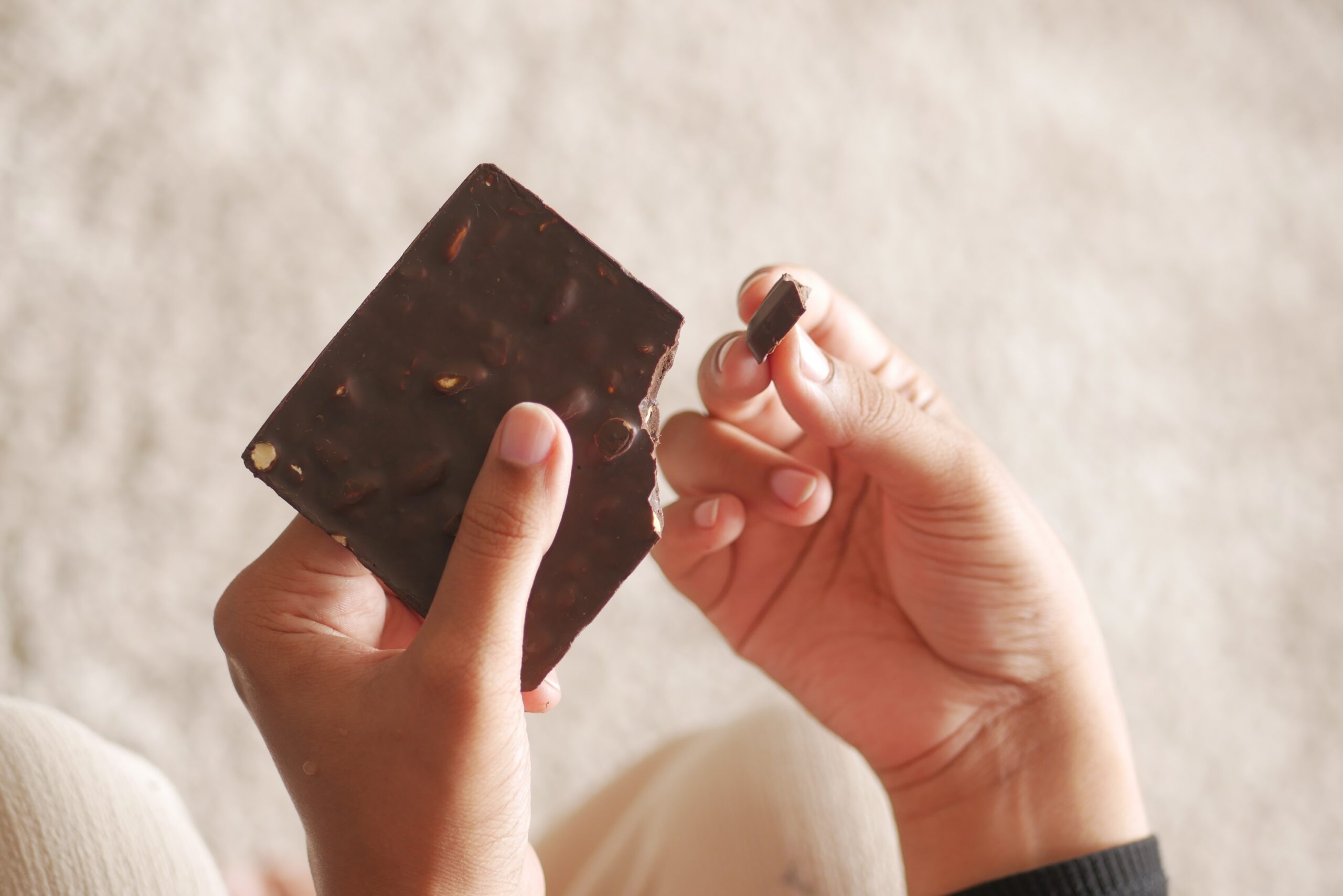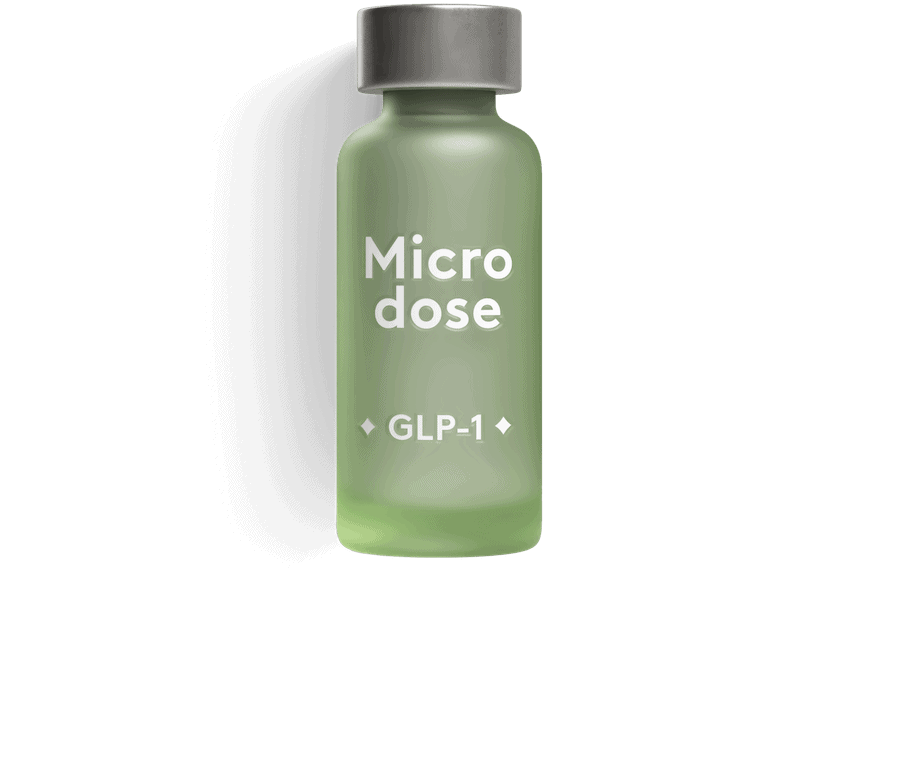Good news for chocolate lovers: You don’t have to skip your favorite treat to reach your goals. In fact, the right kind of dark chocolate can actually support weight loss. Because it’s bolder and less sweet than milk chocolate, even one or two squares can feel like a treat—without derailing your progress.
The key is choosing bars with at least 70% cacao. That higher cacao content means more antioxidants, less sugar, and a rich flavor that lingers—perfect for satisfying a craving without overdoing it. Think of it as a treat that works smarter, not harder.
Ahead, we’ll break down what to look for in a healthier chocolate bar and how dark chocolate’s unique nutritional perks can help tame cravings and keep you on track.
✅ Quick answer
Yes, dark chocolate can support weight loss when eaten in moderation.
✅ Why dark chocolate can support your goals:
- It’s satisfying in small amounts – Its rich flavor, plus a little fiber and healthy fats, makes it easier to feel content with just a square or two.
- It could boost your mood – Dark chocolate stimulates endorphins and serotonin, helping ease stress and reduce the urge for emotional eating.
- It has metabolic perks – Flavanols in dark chocolate may support better insulin function and steadier blood sugar, which can help prevent energy crashes and cravings.
⚠️ Things to be mindful of:
- It’s calorie-dense – Even top-quality dark chocolate is energy-packed. One ounce (about 2 to 3 squares) comes in at 170 calories.
- It’s high in saturated fat – Dark chocolate brings healthy fats to the table, but it also contains about 7 grams of saturated fat per ounce.
- The quality matters – Not all bars are equal. Some brands sneak in extra sugar or use lower cacao percentages, which can cancel out the very benefits you’re looking for.
Rx weight loss, the right way, with Noom
Get access to prescription weight loss medication with Noom.🥗 Nutrients in 70% dark chocolate (per 1 ounce/28g serving)
| Nutrient | Amount | % RDA* |
|---|---|---|
| Calories | 168 calories | 8% |
| Protein | 2.2 g | 4% |
| Total carbs | 12.9 g | 5% |
| Fiber | 3.1 g | 11% |
| Sugars | 6.8 g | — |
| Total fat | 12.0 g | 15% |
| – Saturated fat | 6.9 g | 35% |
| – Monounsaturated fat | 3.6 g | — |
| – Polyunsaturated fat | 0.5 g | — |
| Omega-3 | 0.005 g | — |
| Omega-6 | 0.49 g | — |
These numbers show why portion size matters with dark chocolate. At about 170 calories per ounce, it’s a high-caloric-density food. But you’ll also get a solid dose of fiber (11% of your daily needs) and beneficial fats in a small, satisfying portion. The fiber is particularly valuable because it helps slow down sugar absorption and keeps you feeling satisfied much longer than you’d expect from just one ounce.
*Recommended dietary allowance (RDA) is defined as the average daily amount of nutrients needed to meet the requirements of nearly all healthy people in a specific group.
💊 Vitamins & minerals in dark chocolate (per 1 ounce/28g serving)
| Vitamin/Mineral | Amount | % RDA* |
|---|---|---|
| Copper | 0.50 mg | 55% |
| Manganese | 0.55 mg | 24% |
| Iron | 3.3 mg | 18% |
| Magnesium | 64 mg | 15% |
| Phosphorus | 86 mg | 7% |
| Zinc | 0.93 mg | 8% |
| Potassium | 200 mg | 4% |
| Selenium | 1.9 μg | 3% |
Dark chocolate isn’t just a treat—it’s a genuine source of essential minerals that many people don’t get enough of. The standout star is copper, which helps your body produce energy and absorb iron. Magnesium is another winner, supporting everything from muscle function to stress management.
These mineral levels are genuinely impressive for what many people consider “just a treat.” The iron content is particularly notable for women, while the magnesium can help with everything from sleep quality to muscle recovery after workouts.
🔍 Nutrient breakdown
Glycemic index (GI) of dark chocolate
Glycemic index: 23 (Low)
💡 Tip: Low-GI foods like dark chocolate release sugar slowly into your bloodstream, preventing those energy spikes and crashes that trigger intense cravings for more sweets.
Is dark chocolate high in protein?
❌ No: Dark chocolate contains 2.2 g of protein per ounce, which isn’t considered high-protein.
Better protein alternatives: Greek yogurt | Cottage cheese | Almonds
Is dark chocolate high in fiber?
✔️ Yes: With 3.1 g of fiber per ounce, dark chocolate provides 11% of your daily fiber needs in a small serving.
💡 Tip: This fiber content is one reason why dark chocolate is so satisfying—it actually helps fill you up despite the small portion size.
Is dark chocolate low in carbs?
❌ No: Dark chocolate has 12.9 g of carbs per ounce, making it moderate in carbohydrates.
💡 Tip: If you’re following a low-carb diet, stick to very small portions or choose chocolate with 85% cacao or higher for fewer carbs.
Is dark chocolate gluten-free?
✔️ Yes: Pure dark chocolate made from cacao, cocoa butter, and sugar is naturally gluten-free, though always check labels for cross-contamination warnings.
Is dark chocolate good for fat loss?
✔️ Yes: When eaten mindfully, dark chocolate’s fiber and healthy fats can help control appetite and reduce overall calorie intake throughout the day.
🍽️ Diet compatibility: Which diets include dark chocolate?
| Diet | ✅Yes /❌No | Why |
|---|---|---|
| Keto | ✅ | In very small amounts, high-cacao (85%+) dark chocolate fits keto macros. You’ll need to track net carbs carefully. |
| Paleo | ✅ | Pure dark chocolate without dairy or refined sugar aligns with paleo principles as a minimally processed plant food. |
| Mediterranean | ✅ | Dark chocolate fits perfectly with the Mediterranean diet’s emphasis on antioxidant-rich foods and moderate indulgences. |
| Vegan | ✅ | Most high-quality dark chocolate is naturally vegan, though always check for milk ingredients in cheaper varieties. |
| Gluten-free | ✅ | Pure dark chocolate is naturally gluten-free, though cross-contamination is possible during manufacturing. |
Dark chocolate proves surprisingly versatile across different eating styles. The key is choosing quality over quantity—a small piece of 70%+ cacao chocolate can satisfy your sweet tooth while still fitting into most structured eating plans. For stricter diets like keto, you’ll want to stick to even smaller portions or higher cacao percentages to stay within your daily limits.
🌟 Is dark chocolate healthy? What are the health benefits
Metabolic health: Is dark chocolate good for your metabolism?
- Boosts metabolism? ✔️ Yes – The flavanols and small amount of caffeine in dark chocolate can give your metabolic rate a modest boost by enhancing fat burning.
- Improves insulin sensitivity? ✔️ Yes – Research shows that dark chocolate’s flavanols help your cells respond better to insulin, which is crucial for stable blood sugar and weight management.
- Effect on fat storage? Positive – Better insulin sensitivity means less excess insulin in your bloodstream, which is important because insulin signals your body to store fat.
Cholesterol impact: Does dark chocolate affect cholesterol levels?
- Does it lower LDL (bad) cholesterol? ✔️ Yes – The antioxidants in dark chocolate protect LDL cholesterol from oxidative damage, which is what makes it harmful to your arteries.
- Does it raise HDL (good) cholesterol? ✔️ Yes – Some studies show modest increases in HDL cholesterol with regular dark chocolate consumption.
- Overall impact on heart health? Dark chocolate’s combination of improved blood pressure, better cholesterol profile, and enhanced blood vessel function makes it genuinely heart-friendly in moderation.
💡 Tip: Pair your dark chocolate with other heart-healthy foods like berries or nuts to amplify the cardiovascular benefits.
Can I eat dark chocolate for a calorie deficit?
✔️ Yes, with care: Dark chocolate can absolutely fit into a calorie deficit when you account for its calories and use it strategically to prevent higher-calorie dessert binges.
💡 Tip: Pre-portion your dark chocolate into one-ounce servings so you can easily track calories and enjoy guilt-free indulgence.
Is dark chocolate rich in antioxidants?
✔️ Yes: Dark chocolate contains some of the highest levels of antioxidants found in any food, including powerful polyphenols and flavanols that fight cellular damage.
Does dark chocolate support gut health?
✔️ Yes: The fiber and polyphenols in dark chocolate act as prebiotics, feeding beneficial gut bacteria and promoting digestive health.
Does dark chocolate support digestion?
Positive: The magnesium in dark chocolate helps relax digestive muscles, while the fiber supports regular bowel movements.
Does dark chocolate help you feel satiated and less hungry?
High: The combination of fiber, healthy fats, and intense flavor makes dark chocolate remarkably satisfying for such a small portion.
Satiety Level: High
💡 Tip: Let dark chocolate melt slowly in your mouth to maximize the flavor experience and give your brain time to register satisfaction.
Does dark chocolate help with nighttime cravings?
✔️ Yes: A planned piece of dark chocolate after dinner can provide closure to your eating day, while the magnesium may help you relax for better sleep.
💡 Tip: Save your daily dark chocolate portion for after dinner to create a satisfying end to your eating window.
Does dark chocolate help reduce inflammation?
✔️ Yes: The flavanols in dark chocolate have demonstrated anti-inflammatory properties that may help reduce chronic inflammation throughout the body.
Is dark chocolate beneficial for brain health?
✔️ Yes: Flavanols increase blood flow to the brain, potentially improving memory, focus, and protecting against age-related cognitive decline.
Can dark chocolate improve skin and hair health?
✔️ Yes: The antioxidants improve blood flow to the skin and protect against UV damage, while minerals like iron and copper support healthy hair growth.
Can dark chocolate help balance hormones?
✔️ Yes: Dark chocolate promotes the release of mood-regulating hormones like serotonin and endorphins, while magnesium helps calm the nervous system.
💡 Tip: The mood benefits of dark chocolate can be particularly helpful during PMS or stressful periods when emotional eating becomes more tempting.
🍽️ Best ways to eat dark chocolate for weight loss
- As a post-meal signal: Eat one or two squares immediately after a meal to signal to your brain that eating time is over and prevent dessert cravings.
- Take your time: Let each piece melt slowly on your tongue, focusing on the complex flavors to maximize satisfaction from a small amount..
- Melted and drizzled: Melt a small amount and drizzle over low-fat Greek yogurt or berries to spread the rich flavor over a larger, more nutritious portion.
🍏 Comparing different types of chocolate (Per 1 ounce serving)
| Chocolate type | Calories | Carbs | Fiber | Protein | Fat |
|---|---|---|---|---|---|
| Dark chocolate (90%) | 175 | 8.5 g | 4.2 g | 2.6 g | 13.2 g |
| Dark chocolate (85%) | 170 | 10.1 g | 3.9 g | 2.4 g | 12.8 g |
| Dark chocolate (70%) | 168 | 12.9 g | 3.1 g | 2.2 g | 12.0 g |
| Dark chocolate (60%) | 158 | 15.2 g | 2.4 g | 2.0 g | 10.8 g |
| Milk chocolate | 150 | 16.7 g | 1.0 g | 2.2 g | 8.4 g |
| White chocolate | 151 | 16.9 g | 0 g | 2.1 g | 8.6 g |
This comparison shows the clear progression as cacao percentage increases. Starting at 60% dark chocolate, you can see how each step up in cacao percentage reduces the sugar and carb content while increasing fiber. The jump from 60% to 70% is significant—you get nearly 30% more fiber and notably fewer carbs, which is why 70% is our recommended starting point.
For those who can handle the intensity, 85% and 90% dark chocolate offer even more benefits per bite, with 90% providing almost no sugar and maximum fiber. However, these ultra-dark varieties can be bitter and aren’t for everyone. The sweet spot for most people transitioning to dark chocolate is the 70-85% range, where you get substantial benefits without overwhelming bitterness.
Frequently asked questions about dark chocolate and weight loss
What percentage of cacao should I choose for weight loss?
Aim for at least 70% cacao, though 85% or higher is even better for weight loss. Higher percentages mean less sugar and more beneficial compounds, but they also taste more bitter. Start with 70% and work your way up as your taste buds adjust.
How much dark chocolate can I eat daily for weight loss?
Stick to about 1 ounce (28 grams) per day, which is roughly 3 to 4 small squares. This provides the benefits without overwhelming your calorie budget.
Is dark chocolate better than milk chocolate for weight loss?
Absolutely. Dark chocolate contains three times more fiber than milk chocolate and significantly less sugar. The higher cacao content also means more antioxidants and less likelihood of triggering sugar cravings.
When is the best time to eat dark chocolate for weight loss?
After meals works best for most people. It helps signal the end of eating and prevents dessert cravings. Some people also find it helpful as an afternoon snack to prevent late-day energy crashes.
Can I eat dark chocolate every day and still lose weight?
Yes, if you account for the calories and stick to measured portions. Many people who’ve lost weight and kept it off have a bit of dark chocolate daily because it helps them stick to their overall eating plan long-term.
What should I look for when buying dark chocolate for weight loss?
Choose chocolate with at least 70% cacao, minimal ingredients (cacao, cocoa butter, and small amounts of natural sweetener), and avoid products with added milk fat, artificial flavors, or excessive sugar.
Does the brand of dark chocolate matter for weight loss?
Quality matters more than brand. Look for chocolate that lists cacao or cocoa beans as the first ingredient, has a short ingredient list, and doesn’t include additives like artificial flavors or extra oils.
🧠 Is dark chocolate good for weight loss?
Dark chocolate can absolutely be part of a successful weight loss strategy when you approach it thoughtfully. The key is to choose quality over quantity. A small piece of 70% dark chocolate after meals can be more satisfying and beneficial than larger portions of lower-quality sweets. By working with your cravings rather than fighting them, dark chocolate helps make weight loss feel less restrictive and more like a sustainable lifestyle choice.
📖 Scientific evidence
- People who ate dark chocolate felt fuller and ate fewer calories at their next meal (Nutrition & Diabetes, 2011): Swapping milk chocolate for dark left people more satisfied and less likely to overeat at their next meal, highlighting dark chocolate’s potential role in appetite control.
- People who ate dark chocolate daily saw improvements in their cholesterol levels (Journal of the American Heart Association, 2017): People who incorporated dark chocolate (along with almonds and cocoa) into their diets had healthier cholesterol profiles.
- People who consumed cocoa as dark chocolate, cocoa powder, or drinks had better blood sugar control and lower inflammation (Antioxidants & Redox Signaling, 2011): The antioxidants in cocoa may make your body more sensitive to insulin, calm inflammation, and support heart health.
- People who ate flavanol-rich cocoa products had better blood vessel function and lower blood pressure (Journal of Clinical Biochemistry and Nutrition, 2011): Cocoa flavanols support nitric oxide balance, which helps relax blood vessels and promote healthy blood pressure.
- People who ate about an ounce of 85% dark chocolate daily reported better mood and had healthier gut bacteria after three weeks (The Journal of Nutritional Biochemistry, 2022) – The benefits were seen only with 85% cocoa, suggesting dark chocolate may support mood through the gut-brain connection.
Why you can trust us
At Noom, we’re committed to providing health information that’s grounded in reliable science and expert review. Our content is created with the support of qualified professionals and based on well-established research from trusted medical and scientific organizations. Learn more about the experts behind our content on our Health Expert Team page.























